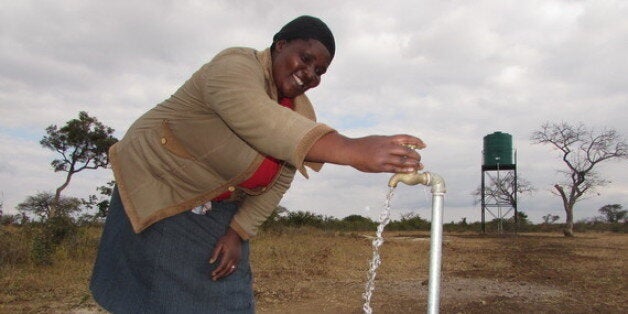
East and Southern Africa is suffering a terrible drought as a result of El Nino. Zimbabwe is one of the most badly affected countries with an estimated four million people - over a quarter of the population - considered to be going hungry.
I recently visited Zimbabwe to see how CARE is responding to this emergency. In the short term, people who have relied on their own small farms for their food and income need immediate help, and CARE - with DFID's support - is providing cash via mobile phones to over 350,000 people . But CARE is also bringing water to communities who don't have it.
Water for health
I visited a community in Masvingo province in south-eastern Zimbabwe, made up of four villages with a total of 310 households and 1,336 people. However, there were no safe water sources for the community.
We were told how villagers would walk up to 14km to collect water from the nearest borehole, when it had water. Girls would often miss school because of this. When the borehole was dry, people would spend the whole night digging in dry river beds to find a bucket full of water under the surface. Women told us that they were scared of being attacked while they were doing this.
At the same time, there were no toilets in the village and so people had to go to the toilet in the bushes. The combination of this and no clean water led to high levels of diarrhoea and other diseases.
Through a project funded by DFID and Switzerland, CARE and UNICEF are now bringing piped water and latrines to rural villages like this one. The project drilled a new borehole near the river which has a good yield. The villagers provided all locally available materials like bricks and sand, and lent a hand digging trenches for pipes to pump the water to five large water tanks around the village. The whole project took a month to complete . The villagers weren't sitting around waiting for charity. We just gave them a bit of help.
There are five 5,000 litre tanks serving 20 water standpoints where people can collect clean water. A locally-run committee allocates 100 litres per day to each household to ensure the borehole does not run dry. (Typical water consumption in the UK is five times that...)
For each tank, the committee collects $50 per month from the 25-100 families that use it. This pays for fuel for the pump and for ongoing maintenance. These are very poor people but they are more than happy to save what little money they have to get clean water. It keeps them healthy, saves them time that would otherwise be spent collecting water, and so makes it easier to earn more money.
Most households also now have an improved pit latrine and out of the four villages, two have attained 'Open Defecation Free' status and the other two are almost. The district environmental health officer said that cases of diarrhoea among children at the local clinic had dropped from 20 a week to six a week since the new water supply became operational in May 2016.
Water for food
In another part of Masvingo Province, called Chivi, I saw one of 50 'small dams' that CARE and World Vision have supported under a USAID-funded programme. It didn't look that small to me. It's 5 metres wide, 7 metres tall and about 34 metres across at the top. It's built of local rocks and cement. Despite the drought there is now 35,000 cubic metres of water behind the dam. The local community is starting to breed tilapia fish in the water. This helps to keep the water healthy but will also be a great source of protein and income in the future.
I didn't say CARE built the dam because it was absolutely the local community that did that. 54 women and 76 men worked hard for almost a year to build this dam. They had to dig out the river-bed until they found hard base rock for a foundation. Then they had to pump out the water and create a base for the dam by moving huge granite boulders - some of them up to one metre in diameter. This was all done with spades, picks, wooden poles and hard work!
Then began the slow work of building each massive step of the dam out of more granite boulders and cement. If you ever thought aid was a handout, talk to these people. They willingly did hard labour for a year in return for nothing more than a bit of food, in order to have the chance to create a dam which would irrigate some land for them, so they could start work again, farming.
So a mile or so down the valley, they had also cleared 3.5 hectares of land (equivalent to five football pitches) and laid irrigation pipes under it, to provide plots of around 250 square metres each for over 100 families. They planted their first seeds in August and were already seeing beautiful green vegetables growing in the middle of this drought-plagued land. One plot is farmed on behalf of the orphans of the community. They already have plans for which crops they can sell to local schools for lunch meals.
The dam and garden are called Musvinini. We were told this means Oasis. And that's what it is: an oasis in a drought.
